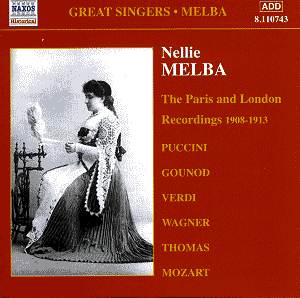Such was the fame of Dame Nellie Melba that even today
hers is one of those names that people uninterested in classical
singing often know, and not just because of the Peach Melbas that
are gulped down in the local ice-cream parlour by young bloods
and blades on their way to the disco. The art of singing, however,
has evolved over the years and present-day listeners are going
to have difficulties.
Take "Vissi d’arte" (slightly preferable
in the remake but either will do for the argument). The timbre
is what the Italians call "fisso" (and it isn’t a compliment),
or what Anna Russell termed "the Nymphs and Shepherds,
or pure white style of singing" (and she didn’t mean
that as a compliment either). That is to say, absolutely straight,
without a trace of vibrato (not in itself a bad thing) and without
even allowing the voice its natural vibrations. Every note is
taken spot on, intonation-wise, there is scarcely any scooping
or umbrella-ing, and when there is it is a small stylistic concession;
the tone is absolutely even right to the highest notes, though
our perception is clouded by the fact that distortion begins,
in these early recordings, at around F sharp. There is no attempt
to give the voice an emotive quality and the aria seems curiously
static (nor does Ronald’s conducting help much here). A singer
friend to whom I played this (one not much given to listening
to pre-war recordings) felt that since the recording has not been
able to capture the upper harmonics of the voice, we just cannot
know what she really sounded like. Certainly, it is difficult
for us to know how big the voice was. Our impression that it was
small and girlish is probably due to the fact that today only
an untrained schoolgirl would be likely to offer a style such
as this. But when we hear the ensemble pieces from "Faust"
and "Rigoletto" we can hear that, assuming she was not
allowed to hog the microphone unduly, she was able dominate what
seems to be fairly lusty singing from her partners. Here, at least,
we can feel the frisson of the theatre. In other words,
the voice seems actually to have been a powerful one, and this
is in itself interesting since a modern singer will probably tell
you that this type of sound is necessarily a small sound;
if you want to increase it you have to let the voice vibrate.
So is this what fascinated her contemporaries, and differentiated
her from other singers of her time?
Another thing you will find different from today’s
singers – but this is true of most singers until the arrival of
Callas – is that she uses very open vowels, not modifying her
As, Es, and Is with a touch of O to make a rounder sound. "Bid
me discourse" is pronounced something like "Bid me discarse".
There is, however, some cause for thinking that the modern concentration
on a rounded sound has gone too far, robbing voices of their forward,
brilliant quality.
So is there anything here for any but the most
historically-minded of today’s listeners? With due caution, I
think there is. It is at least instructive to find that this clean,
pure style produces Mozart for which few apologies need to be
made, and Jan Kubelik is a suitable partner here. He is swoonier
in the Bach-Gounod "Ave Maria" while Melba stays straight
and pure, ennobling the tawdry old sweetmeat. Sir George Henschel’s
"Spring" proves a song that might bear revival (whereas
Sir Landon Ronald composed better pieces than the one recorded
here), but it is the French items that make the best impression.
A couple of items for flute and orchestra by Georges Hüe
came my way not long ago (Black Box BBM1049) and made a favourable
impression. The song here also has a prominent part for flute
and a strong, sultry atmosphere. Strange that this recording was
unpublished at the time. The three versions of the Massenet "Sevillana"
show verve and technique; the one that got published has the voice
closer up and would have been preferable in its day; now that
we can extract so much detail from dim recordings (or at least,
Ward Marston can) it is possible to feel that we get a more rounded
impression of the singer from the more distantly placed takes.
The Duparc and Chausson must have been among the first recordings
of these songs to have appeared. The Chausson in particular left
me thinking that perhaps the very fact that we seem to be eavesdropping,
imperfectly, on a distant age and a distant style, creates an
atmosphere pregnant with Proustian half-memories such as no well-recorded
modern version quite can.
Collectors and students of past singing styles
will need no urging; the name of Ward Marston is a guarantee that
the recordings will sound as well as they are ever likely to (but
what about the controversial Nimbus system, now lost to us?);
the merely curious who are willing to make an imaginative leap
into the past will find much to reward their modest outlay. Back
in their own time the single 78s, judged as a percentage of an
average worker’s income, must have cost at least as much as this
whole CD.
Christopher Howell



